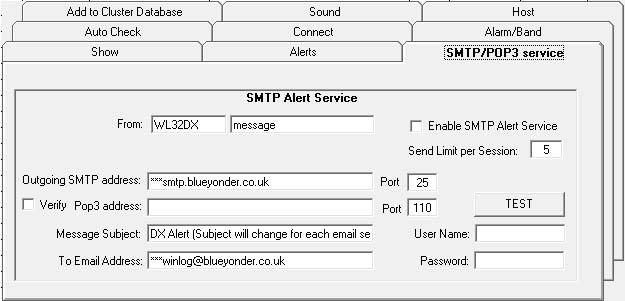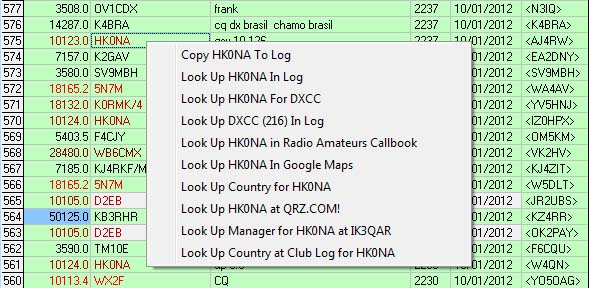|
DXCLUSTER ADVANCED FEATURES, OPTIONS AND SETTINGS
N.B. DXCluster-2 does NOT have all options available
There are many advanced and special features that can further customised the DXCluster.
Click on the DXCluster window 'Options' button #1.
TAB: "Add to Cluster Database"

Option: "ADD SPOT TO DATABASE FROM THESE BANDS".
Spots can be added to a database for future reference, the spots can filtered to bands of interest.
Enabled bands will be added to the database.
It is expected if this option is used that that some filtering will be necessary
to prevent the database swelling over time and slowing Winlog32 DXCluster and the overall system down.

An alarm to purge the database occurs once the database swells to beyond 10,000 entries, and therafter in 5,000 entry steps.
The database entries can be deleted using the DELETE button.
An option to export spot data is available in a delimited text format.
Option: "Auto Add to Database", turns on/off this function, turn OFF this option if this function is of no interest to conserver resources.
Option: "Auto Add WWV and WCY options"
When enabled, this will add solar data from Cluster WWV/WCY spots to the 'Solar' database; graphs track WWV and A/K index.
The Solar database is covered here.
TAB: "SMTP/POP3 service".

Option: "SMPT Alert Service".
This feature enables alerts to be sent to an email address whilst you are not in the shack/home.
This feature is restricted to Registered Users only due to security issues.
N.B. The senders Registered Callsign will be sent in the message body to deter inconsiderate use.
The use of this feature should be restricted so that an unmanageable amount of emails are not sent!
The settings that are needed can be found out from your email client account settings and some care must be taken.
The default SMTP address is an example and this address MUST be changed to that for your outgoing email client.
In MS Outlook - Tools - Accounts - double-click account for settings used.
Option: "Outgoing SMTP address".
Port - this is a default setting but may need changing if required by your email account provider.
Option: "Verify POP3 Account".
This option may be required for certain email services.
Port - this is a default setting but may need changing if required by your email account provider.
Option: "Message subject".
The email subject will start "DXAlert...." - the remainder of message subject will automatically change with each message sent
avoiding duplicate deletions by the email client.
Option: "To email address".
The email address to which the alert message will be sent (your email address).
Option: "Enable SMTP Service".
Turns on this service.
Option: "Send Limit per Session".
This definable value limits the number of emails that can be sent in the current Winlog32 session. Default = 5.
Option: "Username".
Set your email account Username.
Option: "Password".
Set your email account password.
'TEST' button, sends test email, only do this after setting up this service.
Further features and abilities.
Rig Control from a cluster spot.
Click on spot 'FREQ', this will move the transceiver frequency to the spot frequency,
This function will also attempt to determine the mode and change the transceiver mode accordingly.
Generally the band plans will be used to determine the mode, below 14 MHz the SSB mode will be set to LSB else to USB.
Right-Clicking on various fields will show drop-down option list with several functions depending on which field is clicked first.
Select and right-click on 'FREQ' field. 

Option: "Look Up DXCC (##) on ## in the Log".
Displays in 'Search Page' all QSOs with the DXCC on the spotted band, e.g. in the example - all QSO with Chile on 14MHz.
Option: "Return Rig to previous Frequency".
This function works with the RCW.
Select and right-click on 'CALLSIGN' field. 

Option: "Copy *callsign* to Log".
Adds callsign, Date, STime, Frequency to Log ready to add a QSO with spotted callsign.
Option: "Look Up *callsign* in Log".
Searches The Log and displays in the 'Search Page' any existing QSOs with this callsign.
Option: "Look Up *callsign* for DXCC".
Displays Country data and worked/confirmed status for this callsign.
Option: "Look Up DXCC (##) in Log".
Displays all QSO with this DXCC in 'Search Page'.
Option: "Look Up callsign in *Selected Callbook*".
Only if a callbook is set.
Option: "Look Up *callsign* (country) in *Maps*".
Works with the registered version only, integrated maps or google Maps.
Option: "Look Up Country for *callsign*".
Displays full DXCC Country data for the callsign.
Option: "Look Up *callsign* at QRZ.COM".
Displays address and other details from the QRZ (callbook) website.
Registration with QRZ.COM required.
Option: "Look Up Manager at IK3QAR".
Displays QSL manager (if found) from the IK3QAR website.
Option: "Look Up Country at Club Log".
Checks online with Club Log - confirming the DXCC entity.
Select and right-click on 'INFO' field. 

Option: "Look Up *IOTA*".
Displays IOTA data and worked/confirmed status if an IOTA reference is found in the 'Info' field.
Option: "Look Up *IOTA* in Log".
Displays all QSO with this IOTA in 'Search Page'.
Option: "Look Up *IOTA* in Google Maps".
Works with the registered version with google maps feature only,
Option: "Look Up *Grid*".
Displays Grid Locator distance and bearing, plus worked/confirmed status if a grid reference is found in the 'Info' field.
Option: "Look Up *Grid* in Log".
Displays all QSO with this Grid Locator in 'Search Page'.
Option: "Look Up *Grid* in Google Maps".
Works with the registered version and Google maps feature only,
Select and right-click on 'SPOTTER' field.

Option: "Look Up *Spotter* in Log".
Displays any QSO with spotters callsign in 'Search Page'.
|